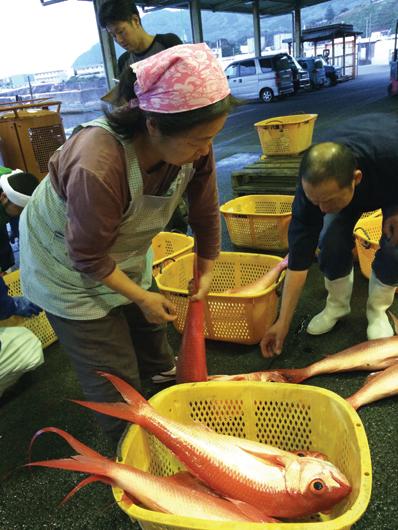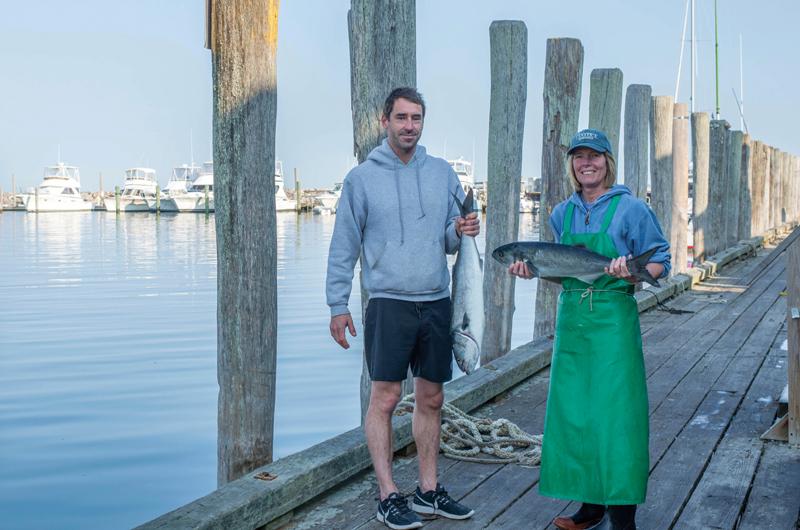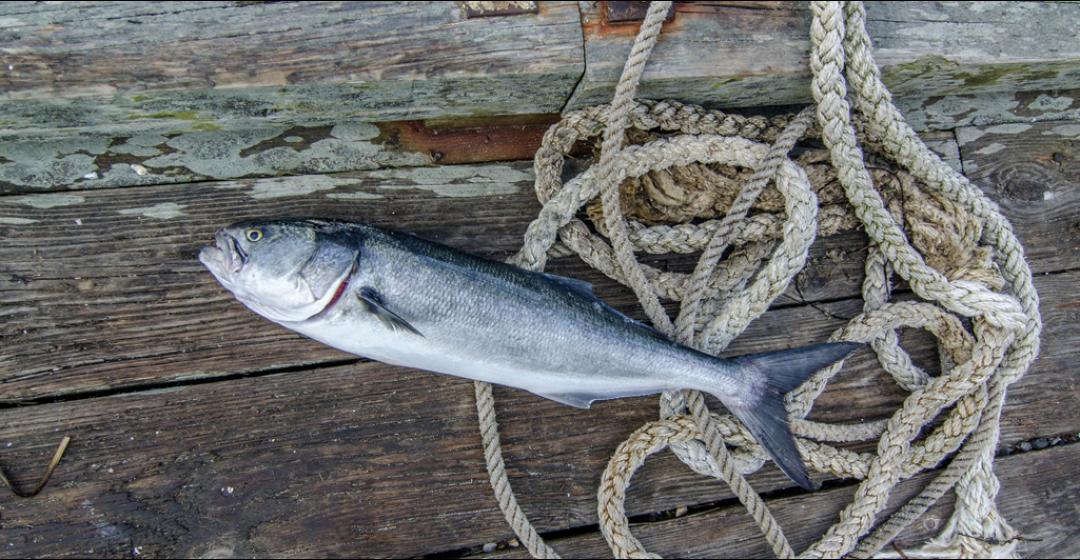There is a sleepy island a fifty-minute puddle jump from Tokyo. Step off the plane in Hachijo-jima and you enter another world. The weather is warm and the sun strong. You are struck by the lush vegetation. You also notice the quiet – this small volcanic island that the Japanese government once sought to position as the “Hawaii of Japan” feels more like Chilmark than Maui. The sense of kinship continues when you reach the market. Fish, some strange but many familiar, all bright-eyed and obviously caught only hours before, have been arranged by the proprietors – two sisters who work with help from their nephew. Do women make the best fishmongers? Betsy and Kristine Larsen, who run their bustling, fresh-smelling shop on the Menemsha docks with help from their cousin Karsten, spring to mind.
The women offer you a slice of raw bonito. The perfect fish is slightly warmer than cool – the ideal temperature to make the complex flavor of the meat sing in your mouth, starting in one key then moving harmoniously to another, leaving you with a memory that lingers delightfully. Later, at dinner in the village, the preparations are almost as simple. But the flavor of these hills and bays are in each mouthful. Lobster sashimi, well-loved on this island, is presented. The familiar sea “spider” shudders, causing you an unbidden moment of hesitation. But then you lift your chopsticks and dive in, only to find the dish so breathtakingly simple and spectacular you finish the plate in silence.
Like all islanders, the people on Hachijo-jima are resourceful. Roughly a quarter of the size of the Vineyard, and isolated at the southern end of the Izu island chain, they have always cultivated what they needed and taken advantage of the surrounding Philippine Sea. Fish, a passion verging on obsession throughout Japan, is handled here perfectly by knowing and skilled fishermen. Even when the remoteness of the island led to its use in the seventeenth and eighteenth centuries as a penal colony, the food here was so obviously memorable that convicts marked a fellow inmate’s imminent release by preparing dishes that highlighted the flavorful ingredients he would miss. The meal typically featured perfectly fresh, raw fish, briefly marinated in island-made soy sauce to season and slightly cure it, both as a precaution and preference, because of the warm climate. Wasabi was never offered, as the root doesn’t grow well in the heat. Instead, strong mustard or hot pepper would accompany the fish. A progression of dishes followed, all made with the best of what is found on and around the island. Goshamen ryori, or amnesty cuisine, is the name of this celebration of local fare, a regional custom that endures.

A taste for raw seafood is strongly identified with Japan, yet it turns out, esteeming uncooked fish began elsewhere in Asia. At the start of the Tang Dynasty, in the seventh century, the Chinese wrote of their relish for fish that had never been heated, sometimes in preparations involving rice, sometimes not. By that time, people in Southeast Asia had been using rice to ferment and preserve fish for generations. The very earliest references to dishes featuring uncooked fish in Japanese cuisine begin in the eighth century. What we think of as sashimi (artfully cut raw fish) and sushi (raw fish on vinegared rice) didn’t catch on until the 1700s.
Interestingly, tuna wasn’t part of the early equation. The flavor was considered too strong – reputedly too strong even for cats. Things began to change in the 1830s, when large numbers of bluefin tuna, usually deep-water swimmers, began to pass close enough to shore to be caught and brought to port without rotting (warm-blooded, tuna spoil quickly). The resulting bonanza inspired the Japanese to bury the catch to lessen the assertive taste. When the “aged” tuna was unearthed, it was marinated in soy sauce and sold – very cheaply – to the extremely poor. The aversion to the big red fish continued among the wealthier, however, until the middle of the last century, when the development of sea-going refrigeration and deep freezers created an opportunity to bring the giants to shore in more or less prime condition. The resulting tuna boom continues to this day: this past January, a Japanese chain paid a record price of 14 million yen for a large bluefin – about $267 per pound. Not surprisingly, perhaps, Pacific bluefin tuna stocks have dropped by more than 95 percent in recent decades.
In the United States, FDA regulations require that all fish served raw in restaurants must be previously frozen – except tuna. There is no evidence that tuna is safer for uncooked consumption than other fish, and no clear explanation for either the rule or the tuna exception. Whatever the regulatory reasoning, the upshot is that most of us have no experience, other than tuna, of eating fish that is both fresh and raw. This is not true in Japan, where people have long enjoyed a diet of fish straight from the ocean. Fresh bream, flounder, mackerel, and bonito are among the species most highly regarded for sashimi and sushi. The Japanese shop carefully, and tend to consider the freshness and quality of a particular fish above all. Even the season is taken into account, as the flavor and texture of a catch changes with the water temperature and spawning cycle.
In Hachijo-jima, an island where people have been eating with the tide for many, many centuries, and where only the freshest sea creatures are served, it is easy to select what is best. You simply head down to the docks or stop at the fish market. The fact is, the same is true here.

Rules of the Raw
On Martha’s Vineyard, we are surrounded by clean waters filled with a wide variety of fish of all sizes. We are in an ideal position to learn to read the stores of our coves and currents and serve the local bounty of flounder (and fluke), mackerel, bluefish, and bonito, raw as well as cooked.
So let’s get down to basics. How long after it leaves the water is fish best to eat? Experts are divided. Some are inclined to think the sooner the better, while others align with the Japanese view that it is preferable to hold whole, ungutted fish on ice at least overnight and, depending on the size and variety, even longer to allow the flesh to “set” and the flavor to develop. Our feeling is: it depends. A bluefish is best “bled” immediately, then fileted, iced, rinsed in sea water, and eaten as soon as you can. Other species, though, do indeed benefit from “seasoning.” If you catch your own, experiment. If you are shopping, trust your eyes and don’t hesitate to ask questions. Buy only fish that looks fresh: clear eyes and red gills if the fish is whole; glistening, moist, evenly colored flesh if it is filleted. Be sure to talk to the folks behind the counter. They will be happy to help.
Once you have your fish, what to do? In Japan, preparing and presenting fish to be served in its natural state is the job of a master chef – his careful knife work transforms filets from a raw product to sophisticated dishes. But you don’t need years of training to turn high quality fish into something delicious. The best way to begin is by thinking about the texture of your fish and let that help guide you as you cut the filets. For most purposes, slices between 1/4- to 1/2-inch thick are nice, although paper-thin slices are also wonderful.
Then give some thought to what accompaniments might be good. In Japan soy sauce and wasabi or grated ginger are generally preferred, but don’t limit yourself to the tried. As the people of Hachijo-jima have long appreciated, what you have on hand may turn out to be best. They use a dab of spicy mustard. In seaside communities elsewhere, other traditions have evolved. In Peru sliced raw fish is doused with lime juice and topped with chiles, cilantro, and corn nuts (tiradito); in Italy they sprinkle slices with sea salt, then dress them with good extra virgin olive oil (crudo); and in Hawaii they mix their shellfish and fish (which they often dice) with ingredients that create taste and textural contrasts (poké; see recipe on next page).
The bottom line: taste what you’ve brought home and suit yourself. We’ve found we like nice 1/2-inch thick slices of perfect bonito with nothing more than a sprinkling of sea salt. We also like fluke sliced so thinly you can see through it, hit with citrus juice and finished with minced fresh hot pepper. And we love straight-from-the-Sound bluefish seasoned with salt, cilantro, mint, or shiso blossoms (see recipe). The truth is, there is no right or wrong. It is all good, especially so because these delicacies come straight to us from the local fishing grounds and we are able to eat them and savor the taste of our own seas.
The following recipes were originally published along with this article:
Lobster Poké
Paper-Salted Bluefish
Pickled Onions







